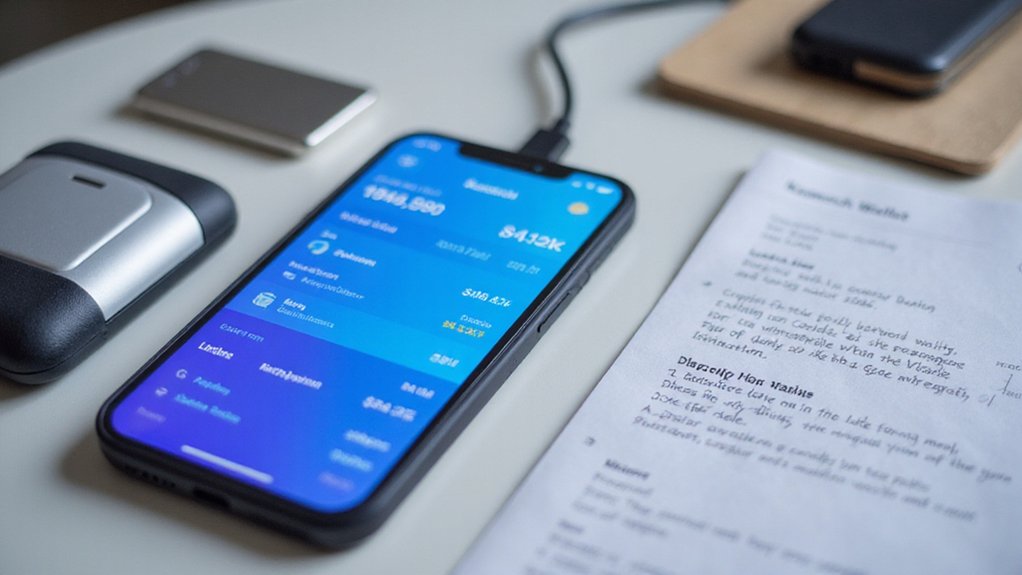Kaanch offers developers a high-performance blockchain platform achieving 1.4 million transactions per second with 0.8-second finality—rather impressive stats for a 2023 newcomer. Its Delegated Proof of Stake consensus, near-zero gas fees, and cross-chain interoperability with Ethereum, Solana, and BNB Chain create fertile ground for dApp innovation. Particularly suited for real-world asset tokenization and AI integration, Kaanch’s extensive ecosystem and 119% APY staking yields make it an intriguing canvas for Web3’s next evolutionary phase.

In the evolving landscape of blockchain technology, Kaanch emerges as a formidable contender poised to redefine digital infrastructure capabilities.
This Layer-1 platform—boasting an impressive 1.4 million transactions per second with a mere 0.8 seconds block finality—provides developers with an architectural foundation that elegantly resolves the blockchain trilemma that has long plagued its predecessors.
Unprecedented speed meets scalability as Kaanch slices through the blockchain trilemma with surgical precision.
One might reasonably wonder how such performance metrics translate to real-world applications; the answer lies in Kaanch’s capacity to support enterprise-scale solutions without the congestion issues that have become the bête noire of Ethereum developers.
The platform’s Delegated Proof of Stake consensus mechanism (not unlike Tron’s approach, though with notable refinements) enables a network of 3,600 active validators to maintain decentralization while delivering near-zero gas fees—a proposition that would have seemed almost fantastical during the height of Ethereum’s gas wars¹.
Developers building on Kaanch benefit from interoperability with major chains including Ethereum, Solana, and BNB Chain, allowing seamless asset transfers across blockchain ecosystems that have historically operated as siloed fiefdoms.
The identity layer incorporating .knch domains provides developers with built-in solutions for wallet identification and role-based access control—features particularly valuable for applications requiring compliance with increasingly stringent regulatory frameworks.
This infrastructure supports ambitious use cases from real-world asset tokenization (real estate, commodities, intellectual property) to AI-integrated applications demanding robust throughput capabilities.
The platform’s architecture is specifically designed to support the Web3 trifecta of DeFi 2.0, Real-World Asset tokenization, and AI integration that will drive the next cycle of blockchain adoption.
Kaanch’s governance model combines DAO-based decision-making with AI-driven optimizations, creating an environment where smart contracts and transaction flows continuously improve through collective intelligence rather than centralized mandates.
Founded in 2023, Kaanch offers a comprehensive developer ecosystem for building secure and efficient decentralized applications with global reach.
For developers weighing platform options, the current staking yields (119% APY at present) offer compelling economic incentives beyond the technical specifications. The platform recently launched its token presale phase for KNCH tokens, providing early adopters with opportunities to participate in its ecosystem growth.
The platform represents a pragmatic synthesis of speed, security, and decentralization—three attributes that have rarely coexisted harmoniously in previous blockchain iterations—making it an increasingly attractive foundation for developers building the next generation of decentralized applications.
¹Those dark days of $200 transaction fees seem increasingly distant, thankfully.
Frequently Asked Questions
How Does Kaanch Compare to Ethereum for Dapp Development?
Kaanch offers compelling advantages for dapp developers through its superior throughput (1.4 million TPS versus Ethereum’s modest figures), sub-second block times, and lower transaction costs—features that particularly benefit high-volume applications.
However, Ethereum’s mature ecosystem, established developer community, and battle-tested infrastructure provide significant counterbalance.
While Kaanch’s DPoS consensus enables remarkable scalability, developers must weigh this against Ethereum’s proven track record, robust documentation, and extensive library support when selecting their deployment platform.
What Programming Languages Are Supported by Kaanch?
Kaanch supports three primary programming languages: Solidity, Rust, and Golang.
Solidity—the EVM mainstay with its 200,000-strong developer community—serves as the platform’s smart contract backbone.
Rust brings its vaunted memory safety and performance benefits (crucial for financial applications where a single misplaced semicolon might vaporize millions).
Meanwhile, Golang’s inclusion offers developers its efficient concurrency model, though it remains somewhat the third wheel in this blockchain programming triumvirate.
What Are Kaanch’s Transaction Fees Compared to Other Platforms?
Kaanch distinguishes itself with near-zero transaction fees, dramatically undercutting Ethereum’s notorious gas costs (which can spike to tens of dollars during congestion).
While platforms like Binance Smart Chain and Avalanche have made strides in fee reduction, they still maintain noticeable transaction costs.
Kaanch’s architecture—supporting 1.4 million TPS with 0.8-second finality—enables this cost efficiency without compromising on performance, making it particularly attractive for microtransaction-dependent applications and real-world asset tokenization where fee structures often determine viability.
How Does Kaanch Ensure Security of Decentralized Applications?
Kaanch fortifies dApp security through multiple layers of defense: its 3600 decentralized validators operating on DPoS consensus prevent centralized vulnerabilities, while AI-optimized governance enables real-time threat response.
Smart contracts undergo AI security optimization, reducing exploit vectors.
The system’s 0.8-second finality minimizes attack windows, and role-based access control via .knch domains secures identity management.
The immutable ledger architecture, coupled with AI-driven transaction monitoring, creates a formidable barrier against potential breaches.
Can Existing Blockchain Applications Be Migrated to Kaanch?
Existing blockchain applications can indeed migrate to Kaanch, though the process isn’t without its intricacies.
EVM-compatible dApps may require adaptation or complete rewriting depending on Kaanch’s virtual machine support.
The platform’s interoperability features—notably Kaanch Bridge—facilitate cross-chain asset transfers, while its near-zero gas fees and impressive 1.4 million TPS throughput offer compelling incentives for migration.
Success ultimately hinges on how tightly applications are coupled to their original chain’s architecture, APIs, and consensus mechanisms.









